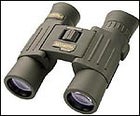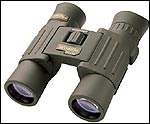Ah, a true Renaissance man—combining vigorous sports like kayaking with more civilized pursuits like bird-watching. What’s your favorite? Northern flicker? Rufous-sided towhee? Pigeon guillemot?
 Wildlife Binoculars
Wildlife Binoculars
The ideal binoculars will offer both sufficient pull and excellent light-gathering characteristics, something along the lines of the 10 (magnification) by 50 (lens-opening diameter) Nikon Action EX Extreme waterproof binocs ($240, www.nikonsportoptics.com). There’s room for debate on the ten-power magnification—some argue that it magnifies shake too much. You have to weigh that against the extra “pull” you get versus a seven- or eight-power binocular. Me? Unless the birds are working a feeder in the yard, I tend to prefer a more powerful pair of glasses.
Trouble is, the Nikons and others of their ilk are more than you probably want to carry. You want some compact binoculars, which while still providing plenty of power will tend to have smaller lens openings and thus a little less light-gathering capability. An example: Minolta’s Compact II ($126, www.minoltausa.com), a pair of 10×25 glasses that bring things plenty close and fit nicely into a pocket. Or take a look at an upgrade, such as Steiner’s superb 10.5×28 Wildlife binoculars. True, the Steiners are $299 (street price is less; www.steiner-binoculars.com), but they’re really wonderful binoculars, with crystal clarity and rugged construction. A lifetime investment, really.
Feast your eyes on more of the best binoculars in ���ϳԹ���‘s
.


